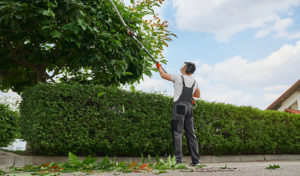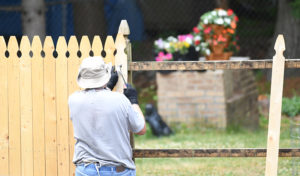When it comes to HOA communities, rules are normal. That is why homeowners living in these communities, as well as buyers who are still considering purchasing a home in these communities, should familiarize themselves with the rules of the association. These include HOA backyard rules.
Are HOA Backyard Rules Legal and Enforceable?
In general, homeowners association rules, including backyard rules, are legal and enforceable. But, it really depends on two things: state laws and the association’s governing documents.
If the laws in your state prevent an HOA from implementing certain backyard rules, then such rules are void and unenforceable. A good example of this is California, which has comprehensive statutes regulating homeowners associations. According to Civil Code Section 4735(a), an HOA may not prohibit homeowners from using low water-using plants or artificial turf.
Another consideration is the association’s governing documents. If the CC&Rs and bylaws contain backyard rules that don’t conflict with the law, then an HOA can enforce those rules. As such, homeowners should check their HOA’s governing documents to understand what they can and can’t do, both in relation to backyards and everything else.
It is worth noting that backyard rules are more prevalent in single-family home communities. Condominium associations typically don’t have such rules because there are no backyards or lawns that belong to individual unit owners. For condominiums, it is more common to encounter HOA rules for potted plants, especially on balconies.
Common HOA Backyard Rules to Know
Backyard rules come in various forms, and chances are, no two communities will have the same exact rules. That being said, some rules are more common than others. Here are the most common HOA backyard rules that homeowners should know.
1. Type of Plants
Many associations regulate the types of plants homeowners can grow in their lawns and backyards. For instance, an HOA may not allow an owner to grow an exotic plant or a plant that poses a threat to the health and safety of residents. Some examples include deadly nightshade, poison ivy, and stinging nettle. An HOA may also prohibit invasive species of plants, such as bamboo, which aggressively spreads and can easily take over the entire neighborhood.
Moreover, associations usually abide by a pre-approved plant palette. This palette is simply a list of plants homeowners can choose from and grow in their backyards. The reason for having a plant palette is to keep consistency and uniformity in the community. It is so that all the homes in the neighborhood can feature the same character and colors, thereby maintaining curb appeal and property values.
2. Personal Gardens
 While an association may not stop an owner from growing a few herbs here and there, it may prohibit large, personal gardens. This is because large fruit and vegetable gardens don’t always look appealing, especially during the off-season. As a result, these gardens can have a negative impact on property values.
While an association may not stop an owner from growing a few herbs here and there, it may prohibit large, personal gardens. This is because large fruit and vegetable gardens don’t always look appealing, especially during the off-season. As a result, these gardens can have a negative impact on property values.
Although personal gardens are great for sustainability, they can also attract wildlife. Stray animals and wild critters might descend upon the community because they have a stable food source. These animals don’t only cause a disturbance but they can also be dangerous.
Fortunately, many communities recognize the need and desire for vegetable gardens. As a workaround, these associations establish a community or HOAs garden instead. With a community garden, homeowners can rent and maintain their own plot of land in a common area where they can plant the fruits, herbs, and vegetables they want.
3. Furniture, Sculptures, and Other Items
Homeowners may want to decorate their lawns and backyards using furniture and sculptures. But, these decorations are not always allowed in HOA communities. More often than not, associations have rules that regulate what objects owners can place in their backyards. For instance, an HOA may not allow large sculptures, offensive decorations, or basketball hoops.
Again, these rules circle back to the objective to maintain the aesthetics of the community. But, there are some rules that also intend to protect the health and safety of residents. An HOA may prohibit fountains or birdbaths, for example, because these water sources can attract mosquitoes.
4. Tree Care
 There are homeowners associations that prohibit trees altogether. In communities where trees are permitted, homeowners often have the responsibility of taking care of these trees. They will need to prune the trees when appropriate and make sure the trees do not become diseased.
There are homeowners associations that prohibit trees altogether. In communities where trees are permitted, homeowners often have the responsibility of taking care of these trees. They will need to prune the trees when appropriate and make sure the trees do not become diseased.
Additionally, if a homeowner wants to cut down a tree, they will usually need permission from the association. Trees do add value to the community, so homeowners can’t just remove them without a valid cause. An HOA board will typically approve the cutting down of a tree if it is dying, has grown too big, or is blocking an entryway or window.
5. Storage Structures
Sometimes, a homeowner will want to build a shed in their backyard for added storage. But, not all communities let owners just build whatever they want. The installation, modification, or removal of sheds usually falls under architectural rules. But, they can also apply to HOA backyard rules.
If an owner wants to build a shed in their backyard, they will likely need approval from the HOA. The board or architectural committee may ask for certain documents, such as a completed application form, blueprints, sample designs, and contractor details. The shed will have to conform to the standards of the HOA, which can include limitations on size, shape, and materials.
6. HOA Approval for Backyard Fencing or Hardscapes
 When done right, fencing and hardscaping can add personality and beauty to a home. But, far too many things can go wrong along the way. This is why most homeowners associations require members to get approval for any hardscapes or fences.
When done right, fencing and hardscaping can add personality and beauty to a home. But, far too many things can go wrong along the way. This is why most homeowners associations require members to get approval for any hardscapes or fences.
The approval process works largely in the same way as the architectural application process. Homeowners will need to fill out a form with all the necessary information, including details about their chosen contractor. They might also need to submit design plans and sample photos of the finished work. The association may ask owners to comply with a list of approved colors or materials, too.
If the project will take a long time to complete, the HOA might require the owner to secure signatures of approval from their neighbors. Large projects can cause a nuisance, after all. Furthermore, homeowners may need to provide a timeline and estimated date of completion. As much as possible, it is important to stick to this schedule.
7. Pools
Associations may also restrict homeowners from building pools, whether in-ground or above-ground. This is usually a way for the HOA to ensure the safety of residents. Pool owners can face liability if a guest or even a trespasser suffers an injury. The HOA may even be dragged into the lawsuit and be held partially responsible if an accident happens.
Additionally, pools can cause damage to the lawn or backyard. If a pool leaks, it can flood the area and spill over to a neighbor’s property. As such, associations tend to have strict rules when it comes to pool maintenance, if the rules allow for personal pools at all.
8. HOA Lawn Maintenance
The HOA is generally responsible for maintaining the common areas and facilities in the community. Similarly, homeowners are responsible for maintaining their individual properties. This includes HOA landscape maintenance. More often than not, associations will require owners to keep their grass or lawns trimmed and clean.
Request to Modify HOA Landscaping
Because of backyard rules, homeowners often find it difficult to express their creativity. However, that does not necessarily mean they can’t modify their yards or lawns altogether. If an owner wishes to construct a deck, change a fence, or plant flowers, they need to seek approval from the HOA first.
The landscaping request process can vary from one association to another, depending on the governing documents. In general, though, homeowners will need to complete a form or submit a written letter requesting the change. The HOA may also ask them to submit supporting documents, such as design plans, a color scheme, and a list of materials. Another name for this process is the architectural change request.
Once the homeowner submits everything, the HOA board or architectural committee will review the request. Based on the governing documents, the board or committee will make a decision. If the board denies the request, it will usually come with a written explanation. The homeowner can then make the appropriate changes to the request and submit it again.
Enforcement of Landscaping Rules and Regulations
To ensure compliance, the HOA will usually conduct routine inspections of the community. Homeowners can also submit complaints about their neighbors’ landscaping or backyard if they feel that they have violated the rules. The HOA board or architectural committee will then review the complaints and investigate further.
When a homeowner breaks a backyard rule, they will typically receive a violation letter. In most states, the HOA board must give the homeowner an opportunity to attend a disciplinary hearing. There, the homeowner can plead their case. Based on this hearing, the HOA board will make a decision and decide whether or not a penalty is warranted.
Can an HOA fine you for backyard rule violations?
While penalties for rule violations can vary, most associations impose a fine. The authority to impose a fine can be found within state laws and the association’s governing documents. Other penalties can range from temporarily suspending the offender’s privileges to legal action.
Can an HOA enter your backyard?
An HOA’s authority to enter an owner’s backyard depends on two things: state laws and the governing documents. Most state laws are silent on the issue, though, so owners will need to turn to their CC&Rs and bylaws. If the governing documents explicitly grant the HOA this authority, then the HOA has a right to enter your backyard to correct a violation or fix a safety issue.
Rules for a Reason
Limiting as they may seem, HOA backyard rules do exist for a greater purpose. They are designed to maintain the aesthetics of the community and ensure consistency among homes. Since they positively affect curb appeal and property values, homeowners should do their best to abide by these rules.
Cedar Management Group assists homeowners associations and condo communities with rule enforcement, among other things. Call us today at (877) 252-3327 or contact us online to learn more!
RELATED ARTICLES:
- 9 HOA Springtime Landscaping Rules For The Community
- 5 Beginner Tips To Follow When Installing A Flower Garden
- HOA Rules Enforcement: Best Practices To Follow






